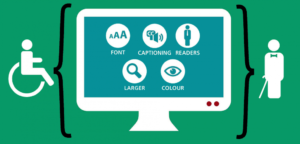Is your Website ADA Compliant?
This is an important challenge which isn’t going away…
You protect your business against lawsuits (and fines) by maintaining an ADA-compliant website.

Equally important – you provide much needed accommodations for your potential customers.
It’s a win/win no matter how you slice it.
What is ADA compliance?
The ADA, which was passed in 1990, prohibits discrimination against those with disabilities, ensuring they have the same rights and opportunities as those without. The act covers all sectors, from jobs and schools to transportation and public/private places open to the public.
In 2010, the U.S. Department of Justice passed the Americans with Disabilities Act Standards for Accessible Design, mandating all electronic and information technology, like websites, be accessible to those with disabilities, like vision impairment and hearing loss.
What does this mean for you?
ADA website compliance equates to making your website conformant with WCAG 2.1 AA technical standards.
For those concerned with business liabilities – here is sobering information.
Web Accessibility Lawsuits are on the Rise:
- 15 Lawsuits in 2013
- 6x increase in lawsuits between 2016 and 2019
- 2,200+ lawsuits in 2019 alone
- Prior to the Pandemic, it was predicted that the number of web accessibility lawsuits would top 5,000 in 2020 alone
These lawsuits target businesses of all sizes, across all industries.
Having accessible technology is more than just the right thing to do – it’s a valuable investment to safeguard your organization against legal risk.
In a nutshell, WCAG requires web content to be:
- Perceivable: Everything can be perceived in more than one way. For example, if someone cannot see; written content can be read by a screen reader.
- Operable: Everything can be operated in more than one way. For example, if someone cannot use a mouse, they can navigate using the keyboard.
- Understandable: Everything can be easily understood. For example, an error message points out the location of your mistake and how to fix it.
- Robust: Everything can roll up to the newest hardware and not break.

Which businesses are required to comply with the ADA?
Under Title I of the ADA, any business with at least 15 full-time employees that operates for 20 or more weeks every year is covered by the law.
Under Title III, businesses that fall into the category of ‘public accommodation’, such as banks, hotels and public transportation, are also required to comply.
What guidelines are available for me to follow?
We recommend following the Web Content Accessibility Guidelines (WCAG). It’s not a legal requirement, but it’s an excellent reference point for organizations looking to improve their digital accessibility.
The best guidance from the ADA itself is an ADA Tool Kit for Website Accessibility for state and local governments (Title II of the ADA) and supplemental Title II Website Accessibility Checklist.
For precedence purposes, U.S. courts and the Department of Justice (DOJ) have continually referenced the Web Content Accessibility Guidelines (WCAG) 2.0 Level AA success criteria as the standard to gauge whether websites are accessible.
The good news is that companies have flexibility in order to maintain compliance, as stated in the Section508.gov blog.
How do I make sure our website is fully compliant – where do I start…?
We recommend scheduling a free call to discuss ADA compliance concerns you may have, with one of our engineers, and determine the best ‘next steps’ necessary to resolve this challenge for your organization.



